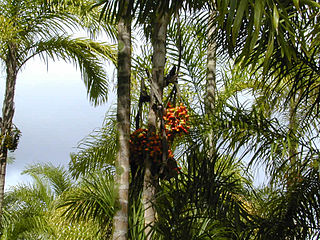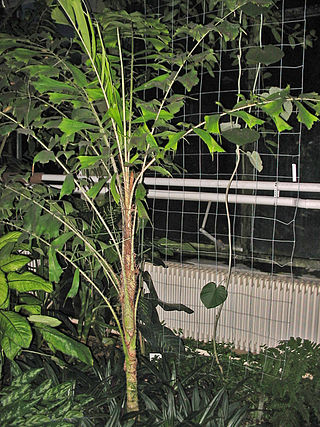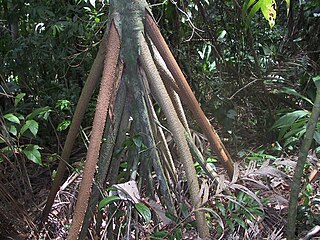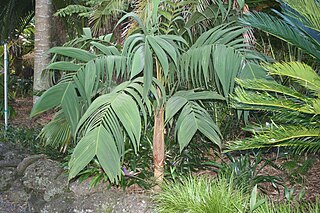
Bactris is a genus of spiny palms which are native to Mexico, South and Central America and the Caribbean. Most species are small trees about 2 m tall, but some are large trees while others are shrubs with subterranean stems. They have simple or pinnately compound leaves and yellow, orange, red or purple-black fruit. The genus is most closely related to several other spiny palms—Acrocomia, Aiphanes, Astrocaryum and Desmoncus. The fruit of several species is edible, most notably B. gasipaes, while others are used medicinally or for construction.

Aiphanes is a genus of spiny palms which is native to tropical regions of South and Central America and the Caribbean. There are about 26 species in the genus, ranging in size from understorey shrubs with subterranean stems to subcanopy trees as tall as 20 metres (66 ft). Most have pinnately compound leaves ; one species has entire leaves. Stems, leaves and sometimes even the fruit are covered with spines. Plants flower repeatedly over the course of their lifespan and have separate male and female flowers, although these are borne together on the same inflorescence. Although records of pollinators are limited, most species appear to be pollinated by insects. The fruit are eaten by several birds and mammals, including at least two species of amazon parrots.

Calyptrogyne is a genus in the palm family (Arecaceae). It is distributed across Central America, Colombia, and southern Mexico, with 11 of the 17 known species endemic to Panama. Calyptrogyne ghiesbreghtiana is the most widespread and best studied species in this genus.
Bactris campestris is a small spiny palm which grows in multi-stemmed clumps in savannas and low forests in northern South America from Colombia to the Guianas, Trinidad and Tobago, and northern Brazil.

Oenocarpus is a genus of pinnate-leaved palms (Arecaceae) native to Trinidad, southern Central and tropical South America. With nine species and one natural hybrid, the genus is distributed from Costa Rica and Trinidad in the north to Brazil and Bolivia in the south.

Prestoea is a genus of palms native to the Caribbean, Central and South America. Its range extends from Nicaragua and the Greater Antilles in the north to Brazil and Bolivia in the south.

Wettinia is a genus of flowering plants in the palm family Arecaceae. The genus, established in 1837, contains some 20 species, but more seem to await discovery considering that 4 species - W. aequatorialis, W. lanata, W. minima and W. panamensis - were described as late as 1995. The genus is broadly divided into two groups. One group has the fruits tightly packed, while the other, formerly classified as genus Catoblastus, has fruits scattered along the inflorescence branches. It is not known whether these groups are both monophyletic. The genus is named after Frederick Augustus II of Saxony, of the House of Wettin.

Desmoncus polyacanthos, the jacitara palm, is a spiny, climbing palm native to the southern Caribbean and tropical South America. Stems grow clustered together, and are 2–12 m long and 0.5–2 cm in diameter. Petioles, rachis, cirrus and peduncular bracts are covered with short, curved spines. Two varieties are recognised: D. polyacanthos var. polyacanthos and D. polyacanthos var. prunifer A.J.Hend.

Wendlandiella is a genus of one species of palms found in Peru, Bolivia and Acre state in Brazil. The genus is named after Hermann Wendland.

Socratea is a genus of five species of palms found in tropical Central America and South America.

Pholidostachys is a genus of palms found in Central America and northwestern South America.

Lepidocaryum is a monotypic genus of flowering plant in the palm family from South America where the lone species, Lepidocaryum tenue, is commonly called poktamui. Nine species names have been published, but palm taxonomists currently agree that just one variable species includes them all. The most reduced member of the Lepidocaryeae, it is similar in appearance to three closely related genera, Mauritia, Mauritiella, and Lytocaryum. The genus name combines the Greek words for "scale" and "nut" and the species epithet is Latin for "thin".

Mauritiella is a dioecious genus of flowering plant in the palm family found in South America where it is commonly called buriti. It is named after the similar and closely related genus Mauritia.
Aiphanes deltoidea is a species of palm which is native to northeastern South America.
Aiphanes eggersii, known locally as corozo, is a species of spiney, pinnately leaved palm which is native to the coastal plain of Ecuador and adjacent dry forests of Peru.

Cryosophileae is a tribe of palms in the subfamily Coryphoideae. The tribe ranges from southern South America, through Central America, into Mexico and the Caribbean. It includes New World genera formerly included in the tribe Thrinacinae, which was split after molecular phylogenetic studies showed that Old World and New World members of the tribe were not closely related.

Prestoea acuminata is a species of palm tree native to Central America, the West Indies and South America.

Geonomateae is a palm tribe in the subfamily Arecoideae. It is an important Neotropical group due to its wide distribution across Central and South America, its diversity and abundance, and the use of a number of species by local human populations. The distribution of the tribe stretches from southeast Mexico down through Central America and into South America, notably Brazil and Bolivia, and species are also found in the Greater and Lesser Antilles. This tribe consists of a group of understory and sub-canopy palms that populate both tropical lowland and montane forests. While members of this group are relatively easy to collect, as they are not canopy palms or spiny palms, and are well represented in herbaria, the taxonomy and phylogeny of the species within the tribe are still uncertain. The resolution of the tribe has been disputed despite the fact that tribe's species are characterized by three morphological synapomorphies: the petals of pistillate flowers are basally connate, the presence of slender and elongate styles, and the flowers are borne in pits in the rachillae.
Bactridinae is a subtribe of plants in the family Arecaceae found in the New World. Genera in the subtribe are:

















